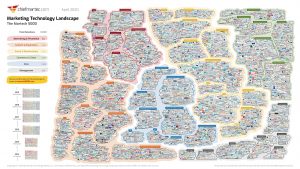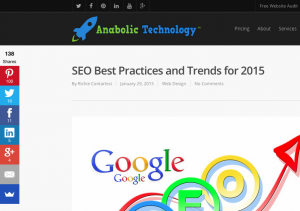The days of digital marketing silos that segment various marketing into stand alone functions are over. To be really effective today, you are going to have to integrate all of your on and offline efforts into a unified strategy. – @Fondalo
Since 2010, every day has been a digital marketing day for me. When I’m not momming, grabbing a quick cup of tea with friends, or roaming the streets of San Francisco (and, of course, I’ve got my trusty iPhone with me so I can Instagram any shareable moments I happen to run into), I’m thinking about digital marketing strategy, digital marketing trends, and even the perfect digital marketing definition. Digital marketing is what I do!
For me, the perfect digital marketing experience is driving traffic to my clients’ websites so that they can convert that traffic into sales if their sites are eCommerce, or capture contact information if they have a service business. This blog post is all about what you, as a business owner, can do to improve your Digital Marketing strategy.
Let’s start with a digital marketing definition.
What is Digital Marketing?
Digital marketing is a set of activities that include:
- Market research
- Planning
- Branding
- Infrastructure (websites, social profiles, reviews)
- Search engine optimization (SEO)
- Content creation
- Social media marketing
- Digital advertising
- eMail marketing and
- Analytics
A digital marketing strategy optimizes these activities so they generate website traffic that leads to a website that has been designed as a marketing tool that either turns visitors into paying customers who buy products or captures contact information so that the website owner (or his or her sales staff) can convert website visitors into clients.
The take-home? Everything a business owner does online should be designed to lead potential buyers to his or her website.
In case the process of digital marketing (described above) isn’t enough to convince you, read on to find out what your customers are doing online, which, in turn, should demonstrate why digital marketing is important.
Why is Digital Marketing Important?
Your customers and clients are online.
If you haven’t read the latest statistics you’ll be interested to know that 72% of adults use social media, 99% use email, and over 64% of web traffic comes from Google searches. For digital natives, these numbers are closer to 100%. How many teenagers do you know who are not on social media, don’t have smart phones, or never use email? What does this mean for business owners?
Many business owners I talk to feel unsure about basic issues like what digital marketing is, whether it affects them, and what they should do about it. They are also concerned about pricing and whether or not they will be getting value out of spending either the time or the money to create and implement digital marketing strategies.
In today’s marketing climate, business owners are increasingly obligated to come up with both offline and online marketing strategies that work together and produce results. It’s easier said than done, which is why digital marketing jobs like mine are on the rise.
The question is not whether to have a digital marketing strategy, but what your business’s digital strategy will be.
What is Your Digital Marketing Strategy?
Have you ever heard of the Goldilocks principle? Derived from “The Three Bears,” the Goldilocks principle is a pricing strategy that relies on creating three product or service offerings at three different price points to capture the high-end, middle, and low-end segments of a market. Often, much like “just-right” porridge, consumers and business owners choose the middle option.
Here are three ways to think about your digital marketing:
- High-end. At this end of the digital marketing spectrum, you can either hire a digital marketer or outsource your marketing.
- Middle. Using the list of digital marketing activities (above), make a list of what needs to get done and decide what you can do yourself, and what you should outsource. If you are disciplined, you can write blog posts and post to social media. It’s best, however, to leave the technical aspects of search engine optimization, programming, and projects like keyword planning, to people with those skill sets and digital marketing experience.
- Low-end. (Can we come up with a different term for this? Low sounds so, well, low . . .) In any case, this option can include working with a digital marketing coach, taking online or offline digital marketing courses, or reading a digital marketing blog or two and implementing the learnings.
If you are just launching a business and don’t have lots of clients or a marketing budget, starting at the low-end can be a good option. The downside is that your business will build more slowly. The upside is that you will come away with a marketable skill and will be able to delegate to your future marketing staff more efficiently.
Whichever option you choose, it’s important to get started. That may sound obvious, but the digital space is increasingly crowded and noisy. The time is now to jump in with both feet, climb the digital marketing learning curve, and start building your brand’s online presence.
Creative Digital Marketing Ideas
As a bonus, I’m going to share an out-of-the-box digital marketing strategy.
An easy way to connect with your online audience is to share content with them that is timely and speaks to their interests. Here is a National Day calendar that lists many of the year’s special days, weeks, and month-long celebrations.
Consider your clients and their interests. In any given month, you’ll find something of interest for practically everyone, whether your clients are hermits, cat-lovers, mule-owners, or international artists. And let’s not forget Halloween: Almost everybody loves to dress up and/or eat candy.
Here’s what to do:
- Select special days that fit with your audience.
- Find legal images that go with the special days (for example: choose a picture of a jack o’lantern if you are posting about halloween).
- Resize the images so that each one is optimized for each social channel.
- Write compelling, shareable copy for each of these posts.
Whenever possible, make these posts linkable to your own website (see above). This can be accomplished by creating web pages or writing blog posts on the same or similar topics and hosting them on your website. And don’t forget images (Not only do images make people more likely to click on your content, hosting images on your own website, including images of products, means you can generate traffic from Pinterest.).
Organize your content using an editorial calendar so that you are sure to focus on topics that interest potential customers and clients. An editorial calendar also helps you create your website’s content, and then post on social media, in an orderly way. It saves time and money to coordinate your content.
Digital & Social Articles on Business 2 Community(52)
Report Post





